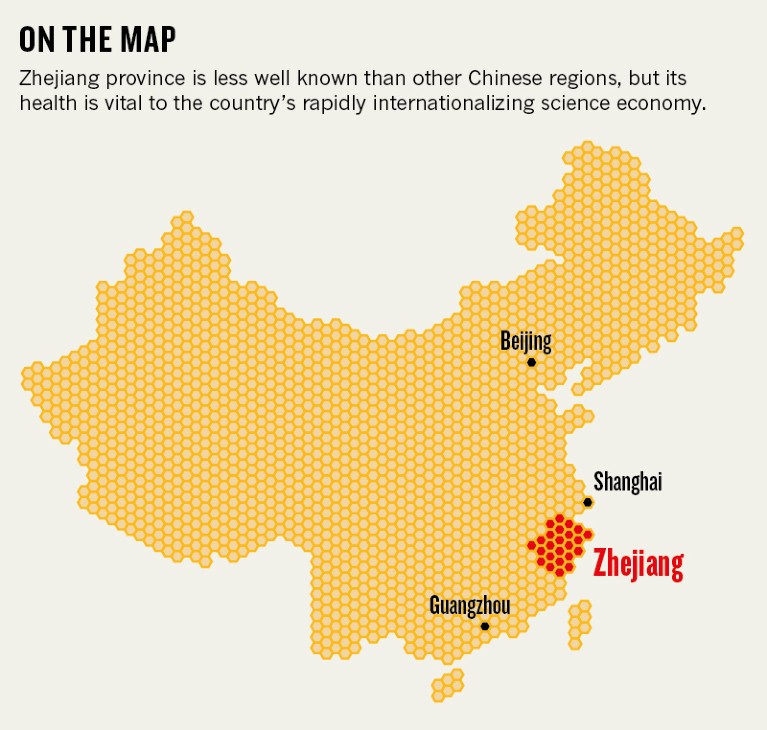
Visitors watch a robot during the 2015 China Yiwu International Manufacturing Equipment Expo & China Intelligent Expo in Yiwu, Zhejiang province.Credit: Xinhua/REX/Shutterstock
Every weekend, busloads of tourists appear at the newly opened International Campus Zhejiang University in Haining City. It is a 20-minute high-speed train ride away from the province’s historic capital city of Hangzhou, home to the campus’s prestigious parent institution, Zhejiang University. The 80-hectare plot, with its modern architecture, water features and pleasant walkways, is a dream for day trippers, who come to picnic by the artificial lake.
The arrival of the tourists initially came as a surprise to Philip Krein, full-time dean of the Zhejiang University/University of Illinois at Urbana-Champaign Institute in Haining. Krein moved there from the United States in 2016 and was not used to seeing universities as tourist destinations. But he’s getting used to the flag-bearing tour guides ushering visitors around the facilities, which opened in 2017. His is one of a number of overseas universities that have daughter institutions or collaborative labs in Zheijiang, including Imperial College London and the University of Edinburgh, UK.
“Academic institutions are extremely important and valued in China,” he says. “People want to see how the country is developing.”
Although the region’s historic strengths lie in its prominence as a shipping hub and as an access point to central China, Zhejiang’s government leaders think that future economic growth will come from investment in its digital economy. At every level of public life, from university programmes to city management, officials are working with scientists and engineers to put cutting-edge science — such as artificial intelligence, big data and cloud computing — at the heart of the region’s development, and to further internationalize the area. Zhejiang’s global significance was affirmed in 2016, when Hangzhou hosted the first Group of 20 (G20) meeting of world leaders ever to be in held in China.
The economic change taking place in Zhejiang reflects the country’s wider ambitions (see ‘On the map’). China’s economy is in a period of rapid transition. The government’s goal, originally set out in a 15-year science and technology plan in 2006, is to transform the country from a low-cost manufacturer into a technologically advanced, innovative economy in which products are no longer just made, but “created”, in China.

By 2049 — the centenary of the founding of the People’s Republic of China — the country plans to be a world-leading science and technology power. It also wants to share its expertise with trading countries across Asia, Europe, the Middle East and East Africa through higher-education initiatives, as part of its ‘One Belt, One Road’ foreign-policy programme, initiated in 2013. That project aims to strengthen economic and diplomatic relationships between China and regional trading partners through the construction of vast infrastructure projects, including roads, railways and docks.
Big picture
Krein says that the clear focus of Zhejiang’s government and its international outlook enables faculty members at his university to think big. On campus, the three foreign universities are in the early stages of planning collaborative projects, such as one at the Biomedical Translational Research Centre, a facility announced in 2018 to focus on turning academic research into technologies that can improve health care.
Krein’s team is also developing a large-scale ‘intelligent’ infrastructure project that uses millions of sensors to evaluate the distribution of bridges, roads and railways, alongside sensors in the water systems, to build up a comprehensive picture of the flow of traffic, waste and people across urban areas. Both projects are in their early stages, but Krein expects funding to come from a consortium of industry and local government.
“We’re not a satellite organization. This is a genuine collaboration,” explains Krein. He is trying to develop unusual, cross-discipline projects and foster teaching styles that encourage greater creativity and curiosity among Chinese students — an endeavour spurred by a wider concern that China’s teaching culture, from an early age, prioritizes rote learning over critical thinking.
A decade ago, China’s government launched an initiative to reverse its academic brain drain, after research revealed that of 1.1 million Chinese people who had left to study overseas since 1978, only 275,000 had returned, as of June 2007 (see go.nature.com/bdrain). High salaries were offered by universities to Chinese-born, Western-trained professors willing to return to China as part of a programme called 1000 Talents.
Despite such efforts, it’s still common for ambitious young scientists to head abroad after finishing their degree in China, because experience in foreign labs remains highly valued. This situation can make it difficult for Chinese universities to recruit high-level talent at the postdoc level, says Jiaming Hu, a neuroscientist at Zhejiang University. Hu says that universities often require newly hired professors and associate professors to have at least two years of research experience abroad.
Yet early-career Chinese scientists who choose to stay in Zhejiang can be in a strong position to find rewarding jobs, both in state-funded and commercial labs, given that the province is betting much of its future on science and technology development. Hu’s lab is just 3 years old, and the product of a US$25-million, 5-year investment into the institute. That money also bought a large primate facility, which Hu says is unlike anything he’d find in the West. “Some of my friends went to foreign labs and sometimes find it not that easy to get all the animal resources that they need,” Hu says.
Researchers are also finding that, even if they stay in China, opportunities to collaborate with foreign scientists are growing. Materials scientist Yong Wang, who returned to China in 2012 as part of the 1000 Talents programme, says that Zhejiang University offers multiple programmes to enable staff and students to go abroad for a short stint.
Guohua Xu, an evolutionary geneticist who works alongside Jiaming Hu at Zhejiang University, adds that leading scholars frequently visit the campus and give talks. Both Hu and Xu highlight the generous funding researchers in China enjoy. “The advantage is that we often have equipment many Western universities do not have,” Xu says. “The disadvantage is that we are not yet at a high enough level to compete with the best international teams and attract the best talent.”
But that generosity isn’t always balanced across research fields. A reform of the funding system, announced in March, seems to shift priorities away from basic-science research and towards government-sanctioned projects, at a time when many prominent Chinese researchers say that China’s spending is already too low compared with other nations.
Wang remains optimistic. “I think it’s possible to do both. To work within international teams and pursue universal truths, and also achieve China-specific goals,” he says.
For entrepreneurial scientists in Zhejiang, many routes are available for turning research into commercial products. Zhejiang University has invested in its own industrial park, 1 of 15 similar science parks across China that are designed to act as incubators for commercial enterprises and start-ups. Funding comes from both the private and public sectors. Recent commercial successes include Drore Technology, which offers tourism-focused smart technology such as interactive maps and intelligent audio guides, and NationalChip, which manufactures computer chips for television systems.
Last year, the province’s capital opened a 113-square-kilometre zone for the development of science and technology, called Hangzhou Future Sci-TechCity. Within the site lies AI Town. It opened last year, and plans to have 20,000 researchers and 200 innovation teams, led by top scientists and industry pioneers, on site by 2022. The vast collaboration will bring together innovative companies, such as Alibaba and the Chinese Internet giant Baidu, with a variety of prominent university teams.
The impetus to turn research into viable products is embedded into university culture, says Anna Wang Roe, a neuroscientist at Zhejiang University. Staff and postdocs are encouraged to apply for opportunities to set up new ventures. All of this comes with a price tag: each year, the province invests around $20 million to $30 million in Zhejiang University to encourage the development of companies. In early 2018, the province reported that, between 2013 and 2017, the number of high-tech enterprises had more than doubled, to 11,462, whereas small and medium-sized science and technology enterprises had increased eightfold, reaching 40,440.
Pioneering roots
“The local government here has always looked ahead,” says May Tan-Mullins, who studies international relations at the University of Nottingham Ningbo China. “Fifteen years ago, as the city was growing, they planted trees, when no other Chinese cities did. Locals complained they were wasting money that should be spent on houses. Now people appreciate the city’s green belt.”
Tan-Mullins’s institution — a joint venture between the University of Nottingham, UK, and the Zhejiang Wanli Education Group — is a reflection of an internationalizing China. “We have staff from over 50 countries and students from more than 70,” says Tan-Mullins.
Although the university’s major market is still domestic, about 10% of students come from overseas — the highest proportion of any Chinese university. And 90% of faculty members are international. “We joke that on our 144 acres of land, we probably have the highest concentration of foreigners in China,” says Tan-Mullins.
“It’s brought Ningbo on to the global stage,” she says. “And also onto the China stage.”


 The zest of Zhejiang
The zest of Zhejiang
 Career guide: China
Career guide: China
 China declared world’s largest producer of scientific articles
China declared world’s largest producer of scientific articles
 How private-sector research is changing China
How private-sector research is changing China








